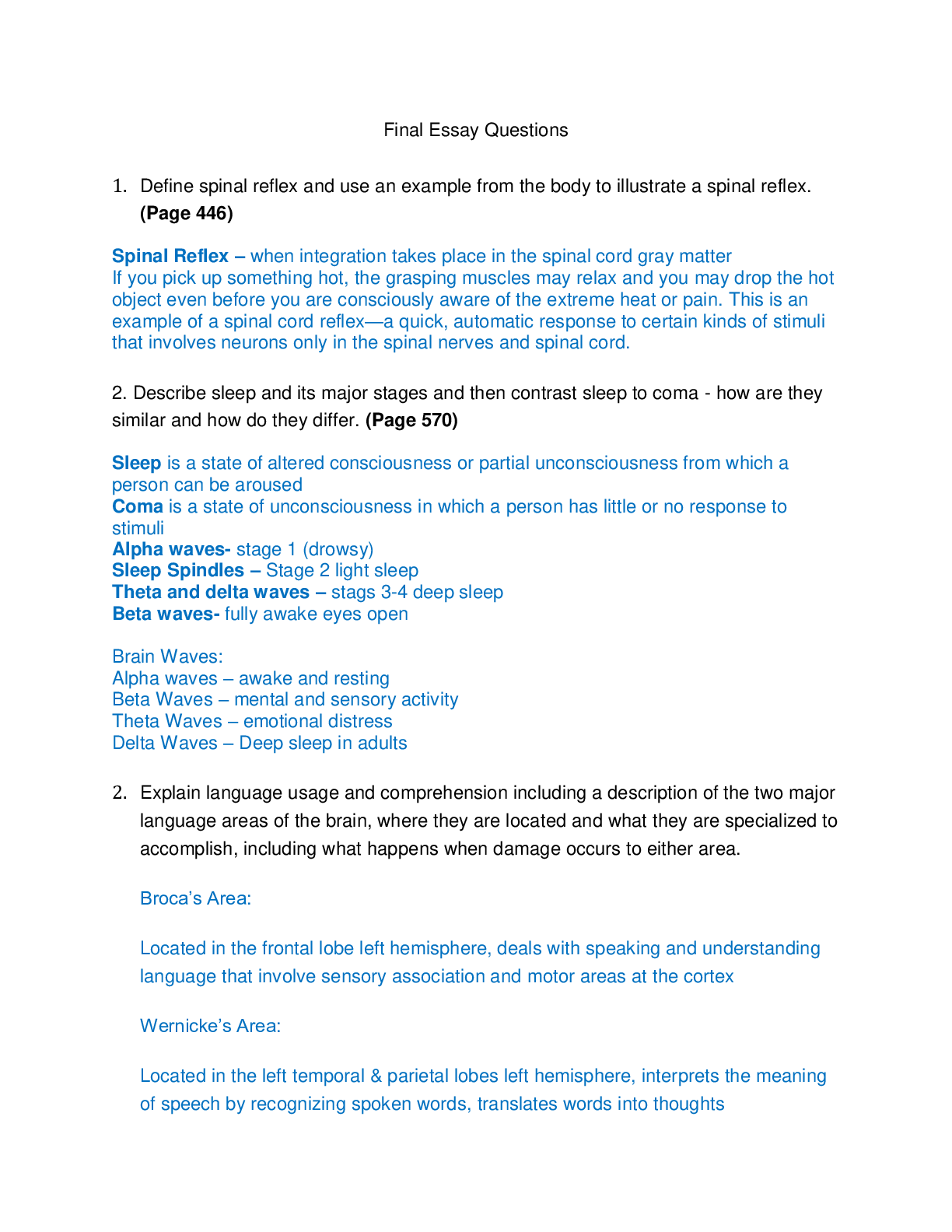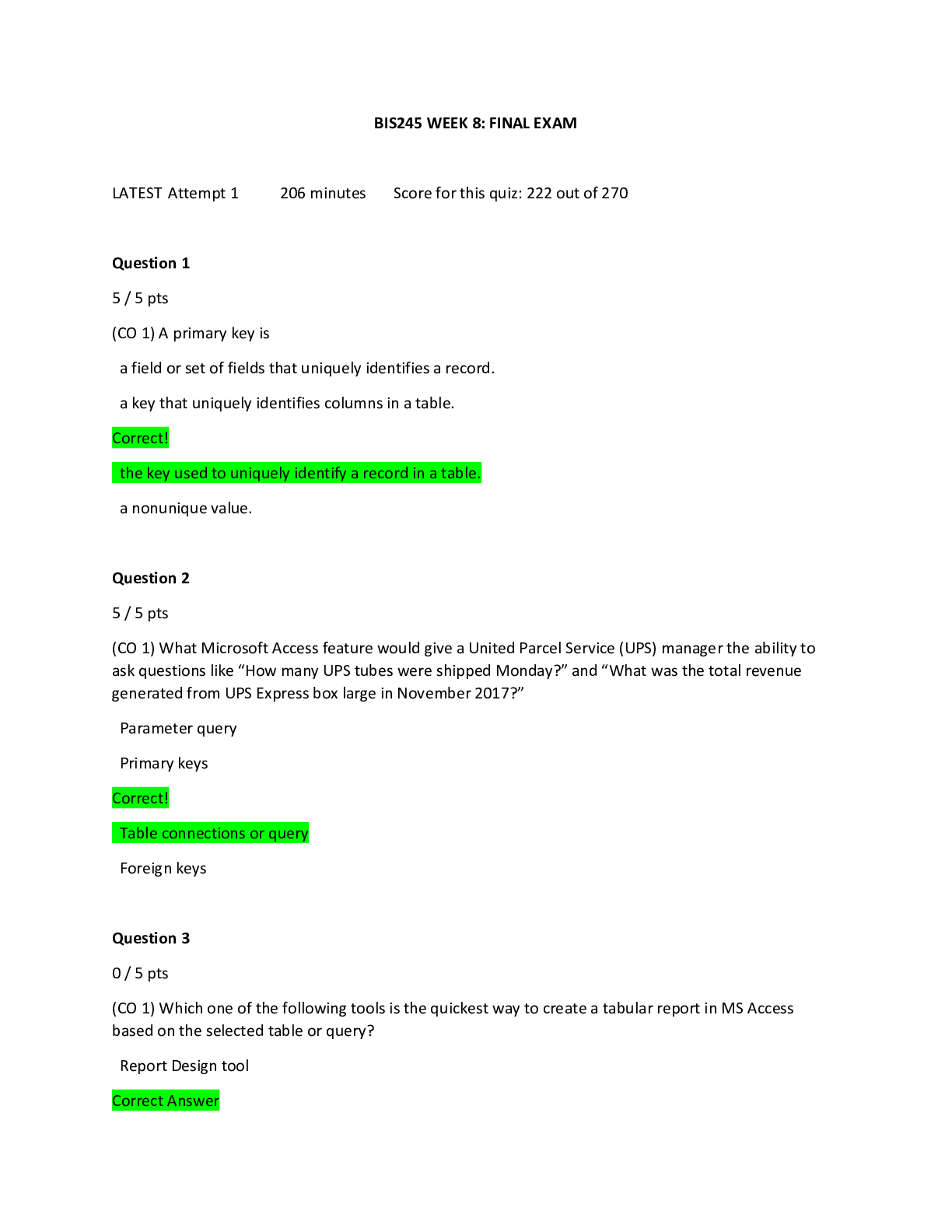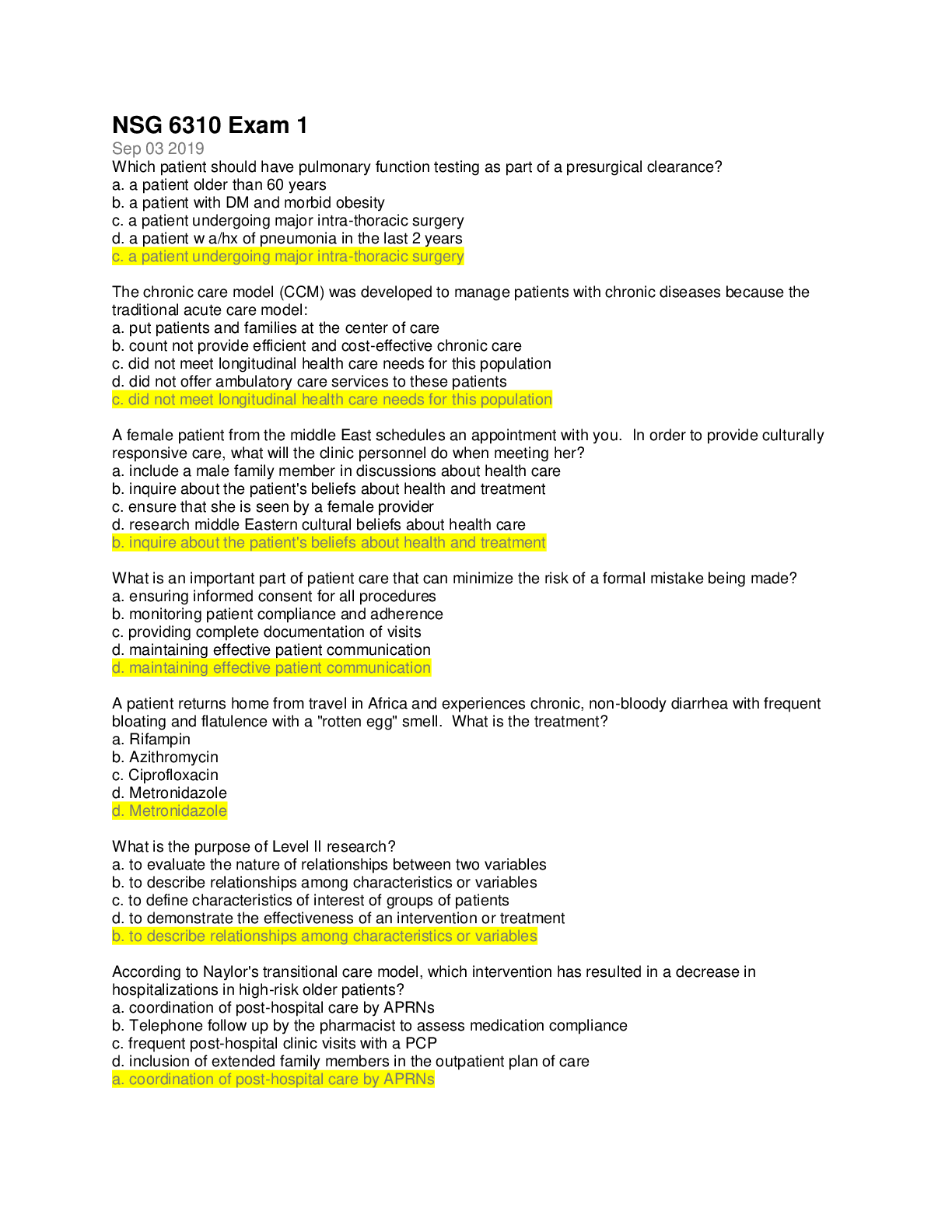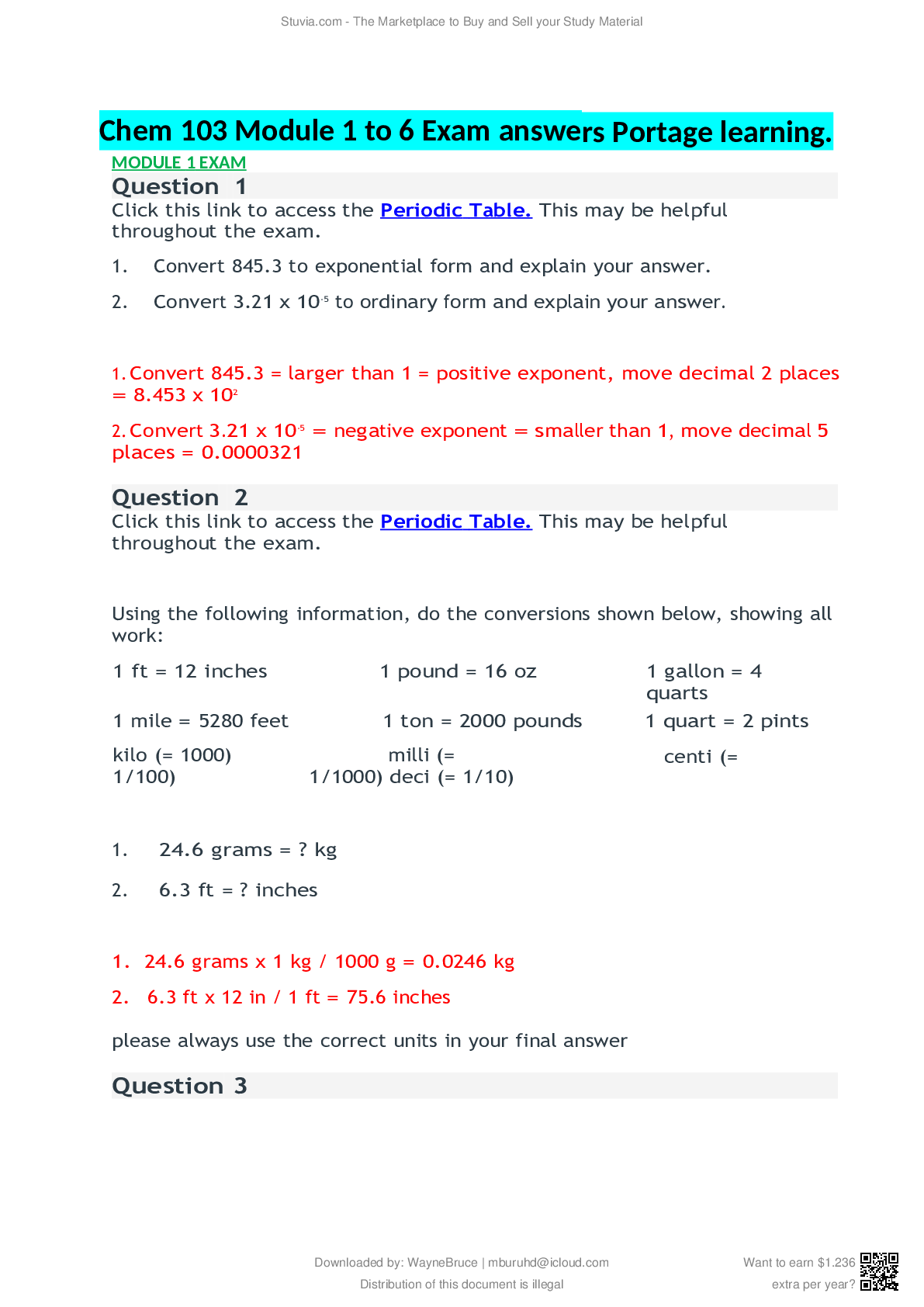NSG 6430 | week 7 case study Answered Updated Fall 2025.
Document Content and Description Below
Review Questions MCGRAW HILL ACCESS SUPPORT SUBSCRIBE edgar harvey Keyword Search Case Files Collection Search About Search Access Provided by: SOUTH UNIV... ERSITY SAVANNAH 5010 Basic Science Cases Basic Science Cases Clinical Rotation Cases Clinical Rotation Cases Post-Graduate Cases Post-Graduate Cases Podcasts/Audio Podcasts/Audio My Case History My Case History 33.1 33.1 AA ✓✓ BB CC DD EE Glomerulonephritis (Acute Poststreptococcal) > Quiz Results Quiz Results Your Score: 100 % Your Score: 100 % You answered 3 of 3 questions correctly. Question Question 1: 1: Correct Correct A 6-year-old boy presents with a new onset of oliguria and hematuria shortly a!er he has recovered from an untreated sore throat. Additional workup finds hypertension, periorbital edema, and impaired renal function with slightly increased amounts of protein in the urine. A renal biopsy most likely would reveal electron-dense deposits in which of the following sites? Between the basement membrane and endothelial cells of the glomeruli Between the basement membrane and epithelial cells of the glomeruli Between the basement membrane and epithelial cells of the proximal tubules Within the mesangium of the glomeruli Within the juxtaglomerular apparatus ✓✓ AA BB CC DD EE The correct answer is BB. You answered BB. Explanation: B. B. Acute di"use proliferative glomerulonephritis most commonly presents in children a!er a group A β-hemolytic streptococcal infection; this explains the other name of this disorder: acute poststreptococcal glomerulonephritis. Children develop signs of the nephritic syndrome with hematuria, mild periorbital edema, and increased blood pressure. This disorder is characterized by irregular larger subepithelial (between the basement membrane and epithelial cells) electron-dense deposits. 67 67% of users answered correctly. Source: Case Files: Pathology 2e Question Question 2: 2: Correct Correct Which of the following is the histologic hallmark for the diagnosis of rapidly progressive glomerulonephritis? Crescents within the glomeruli Fibrinoid necrosis of the e"erent arterioles Fibromuscular hyperplasia of the a"erent arterioles "Spike and dome" appearance of the glomerular basement membrane "Tram-track" splitting of the glomerular basement membrane The correct answer is AA. You answered AA. Explanation: A. A. Rapidly progressive glomerulonephritis is characterized histologically by the presence of crescents within glomeruli (crescentic glomerulonephritis). A crescent, which is defined as having at least three layers of cells between the visceral and parietal epithelium, is composed of visceral and parietal epithelial cells, inflammatory cells, and fibrin. The three basic types of RPGN, defined by the immune pathomechanism, are anti-GBM disease (linear immune deposits), immune-complex–mediated disorders (granular immune deposits), and the pauciimmune type (very few immune deposits). 67 67% of users answered correctly. Source: Case Files: Pathology 2e Basic Science Basic Science Cases Cases Clinical Clinical Rotation Rotation Cases Cases Post- PostGraduate Graduate Podcasts/Audio Podcasts/Audio My Case My Case History History Case Files Collection Case Files Collection Sites Sites AccessAnesthesiology AccessAPN Accessartmed AccessBiomedical Science Support Support Training & Support Contact Us Submit Feedback McGraw Hill Medical McGraw Hill Medical 33.3 33.3 ✓✓ AA BB CC DD EE Email Results Return to Top of Results Retake Print Results Question Question 3: 3: Correct Correct A renal biopsy from an adult who presented with progressive renal failure and hematuria reveals linear deposits of IgG within the glomeruli. Which of the following types of autoantibodies is most likely to be present in this individual? Anti-basement membrane antibodies Anticentromere antibodies Anti–-double-stranded DNA antibodies Antimitochondrial antibodies Anti–smooth muscle antibodies The correct answer is AA. You answered AA. Explanation: A. A. Type I rapidly progressive glomerulonephritis is characterized by the finding of linear deposits of IgG and C3 within the glomerular basement membrane using immunofluorescence. Patients usually present with massive hemoptysis and acute renal failure. Most patients are found to have Goodpasture disease, in which autoantibodies to the glomerular basement membrane are present. These autoantibodies are directed against the noncollagenous portion of type IV collagen. 71 71% of users answered correctly. Source: Case Files: Pathology 2e AccessDermatologyDxRx AccessEmergency Medicine AccessHemOnc AccessMedicina AccessMedicine AccessNeurology AccessObGyn AccessPediatrics AccessPharmacy AccessPhysiotherapy AccessSurgery AccessWorldMed Case Files Collection Clinical Sports Medicine Collection F.A. Davis AT Collection F.A. Davis PT Collection JAMAevidence Murtagh Collection OMMBID Pharmacotherapy Principles & Practice Subscribe Subscribe Institutional Subscriptions Individual Subscriptions Access Access My Dashboard My Settings [Show More]
Last updated: 5 months ago
Preview 1 out of 4 pages

Loading document previews ...
Buy this document to get the full access instantly
Instant Download Access after purchase
Buy NowInstant download
We Accept:

Reviews( 0 )
$8.00
Can't find what you want? Try our AI powered Search
Document information
Connected school, study & course
About the document
Uploaded On
Aug 31, 2019
Number of pages
4
Written in
Additional information
This document has been written for:
Uploaded
Aug 31, 2019
Downloads
0
Views
117



















